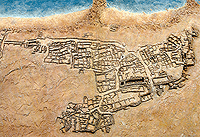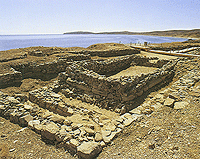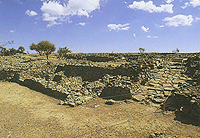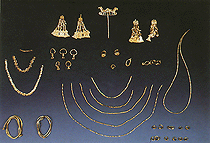The settlement of Poliochni was built in the Final Neolithic period (4th millenium BC) on a low hill of the eastern coast of Lemnos, in the cove of the protected bay of Vroskopos. The location of the settlement in the vast breadbasket of the island brought about the development of the agrarian economy and the ensuring of surplus which could cover the nutritional needs of several hundreds of inhabitants. Furthermore, the location of Poliochni in one of the most safe anchorages of sea trade routes from and to the Black Sea and opposite Troas quickly resulted in its excessive economic development and its evolution into one of the earliest and most significant early urban centres of the Early Bronze Age (3rd millenium BC) in the Aegean which competed with the powerful settlements of the neighbouring coast of Asia Minor, Troy and Liman Tepe (Klazomenai). Seven building phases are distinguished in the architectural remains of Poliochni. These verify the habitation of the settlement from the Final Neolithic until the Late Bronze Age. The so-called Poliochni Black belongs to the Final Neolithic. The Poliochni Blue, Green, Red and Yellow periods belong to the Early Bronze Age (3000-2300 BC), Poliochni Brown covers the Middle Bronze Age while Poliochni Violet corresponds to part of the Late Bronze Age. There are two gaps in occupation: one at the end of the Early and one during Late Bronze Age. The settlement of the Early Bronze Age was gradually extended on an area of 13.500-15.000 square metres. It was comprised of entirely stone-built buildings with rectangular or irregular rooms and yards, organized in building insulae of various sizes. The basic building unit was the long and narrow rectangular tripartite building (megaroid), on the long sides of which one or two rows of narrow supplementary rooms were attached, these being mainly storerooms or workshops. A central road, parallel to the shoreline, runs the settlement from south to north and is crossed vertically by smaller roads, thus ensuring communication with the most isolated insulae. This is the earliest known example of the "linear" building system in the Aegean and the Balkans which is later applied in Thermi V on Lesbos and Troy IIg. Poliochni is fortified from the Blue period with a monumental fortification wall, built of rectangular or polygonal building blocks which is preserved 4,5 high. The stone wall is constantly extended until the Yellow period toward the side of the land and it includes gates reinforced with rectangular or trapezoid towers. The objective of these works is protection against sudden flooding of the stream that flows in the south part of the settlement and the defense of the communal goods from probable external claims. The exemplary town planning of the settlement -which offered shelter to at least 1500 inhabitants during the last phase-, the existence of a fortification wall, the functional roads, the two squares with public wells, the extensive sewage system under the carefully paved streets, the squares and courts, all give the picture of a well-organized town, already from the beginning of the 3rd millenium BC, which is rightfully determined as the first town of Europe. The coordination and realization of works of public interest, such as the fortification system, the roads, the wells, suggest the existence of a coordinating body as well as the consent and participation of all the inhabitants in matters of public interest. The "Communal storehouse", which is known as "Granary", and the oldest in Europe "Communal assembly room", known as "Bouleuterion" around the south gate of the wall, as well as the monumental megaron 317 dominating over the north and largest square of the settlement, constitute irrefutable evidence of the political organization of Poliochni in the beginning of the 3rd millenium BC. The economic organization and social composition of the community is traced, not only in the architecture, but also in the quantity and the distribution of the finds in the different architectural periods. All the families without exception contributed to the agrarian economy. Textile manufacture, the products of which were exchangeable commercial goods, was an activity of most households. Metalworking was a specialized activity which however did not constitute the monopole of one family. The acquirement of the indispensable raw materials and the promotion of bronze, either as a raw material or as in the form of end products gave an impetus to the commercial contacts with Troy and particularly the Cyclades and mainland Greece. At this point we should underline the role of Poliochni in marine trade and its contribution to the diffusion of bronze metalworking in the central and south Aegean. The diffusion of this know-how and of the pottery types of the northeastern Aegean are likely to have resulted from population movement from the islands of the north Aegean to the south during the phase Lefkandi I-Kastri. The intensive practice of trade effected the concentration of wealth in the hands of skilled workers and merchants already from the 3rd millenium. This is expressed by the presence of marble vases and bone tubes (chromatothikes) from the Cyclades, Cycladic and mainland pottery but also by the treasuring up of bronze tools and weapons (treasure of Red Poliochni) and gold jewellery (Yellow Poliochni), similar to those of the so-called "Prian's treasure" which were found in Troy IIg. The economic prosperity of Poliochni was interrupted in the Red period by an unexpected strong earthquake which made the inhabitants abandon the town.
|
 |
|
|
Poliochni. Model of the Early
Bronze Age settlement. |
||
 |
||
|
Poliochni, Red period. View of megaron 317.
|
||
 |
||
|
Poliochni, Red-Yellow period.
View of the southwestern gate.
|
||
 |
||
|
Poliochni. The gold jewellery of
the "treasure" of Poliochni Yellow. |
||